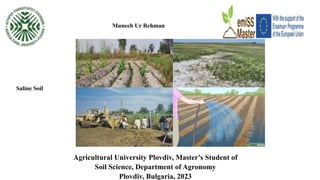This document discusses soil salinity, its effects on plant growth, and recommendations for managing saline soils. It defines soil salinity as the salt content in soil and explains how soils become saline through natural and human-caused processes like irrigation. It then describes how salinity reduces water uptake in plants and inhibits their growth. The document also provides a scale of crop salt tolerance and notes Pakistan has over 6 million hectares of salt-affected land. Finally, it recommends drainage, use of salt-tolerant crops, and adding organic matter to help reclaim saline soils.















